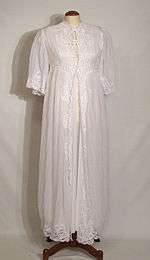Peignoir
A peignoir (pronounced [pɛ.ɲwaːʁ]) is a long outer garment for women which is frequently sheer and made of chiffon or another translucent fabric. The word comes from French peigner, to comb the hair (from Latin pectināre, from pecten, pectin-, comb) describing a garment worn while brushing one's hair, originally referring to a dressing gown or bathrobe.


Very high-end peignoirs were occasionally sold with sheer long gloves and stockings made of the same material as the peignoir itself for wear to bed or on occasions where the wearer would be seen in her nightclothes, such as visiting or while sharing accommodations during travel during the mid-19th to mid 20th centuries. Contemporary peignoirs are usually sold with matching nightgown or panties.
In popular culture
A peignoir is worn by Edna Pontellier, protagonist of the novel The Awakening by Kate Chopin (1899), mostly as a dressing gown. "Mrs. Pontellier was by that time thoroughly awake. She began to cry a little, and wiped her eyes on the sleeve of her peignoir. Blowing out the candle, which her husband had left burning, she slipped her bare feet into a pair of satin mules at the foot of the bed and went out on the porch..."
In Arnold Bennett's novel The Old Wives' Tale (1908), the character Sophia Baines, an Englishwoman living in Paris, associates the peignoir with loose living and idleness even though she wears one herself: "She decided that on the morrow she would dress herself 'properly,' and never again wear a peignoir; the peignoir and all that it represented, disgusted her."
In Max Beerbohm's novel Zuleika Dobson, the chief character, Zuleika, is described in chapter one in a scene set in Judas College, Oxford, as resting "in a white peignoir tied with a blue sash...in a great chintz chair, gazing out of the bay window".
It is also mentioned in opening chapters of the novel Tender Is the Night by F. Scott Fitzgerald, where it is described in the context of beach attire.
A peignoir is notably featured in the opening stanza of the poem Sunday Morning by Wallace Stevens.
In John Fowles' 1969 postmodern historical fiction novel The French Lieutenant's Woman, set in 1867, Ernestina Freeman wears a Peignoir in chapter five.
In Fawlty Towers a flirtatious Frenchwoman has the character name "Mrs. Peignoir".
In the episode of Frasier entitled "The Seal Who Came to Dinner", Frasier and Niles dress a dead seal in Niles's absent wife's peignoir to avert the attention of the guests attending his exclusive dinner party, leading to accusations that he had murdered her.
In the episode of Columbo entitled "Death Hits the Jackpot" (December 1991), Columbo is thinking about possible anniversary presents for his wife, and is taken aback to learn that a nightie and peignoir would cost him $425.
In a 1988 Doonesbury cartoon strip, the inept Jeremy Cavendish gives Lacy Davenport a peignoir while they are attending a game on their second date.[1]
In City of Bones by Cassandra Clare, Isabelle Lightwood wears a "pink peignoir set" when devising battle strategies to secure the Mortal Cup.
In the episode "A Scandal in Belgravia" of Sherlock, Irene Adler is briefly seen wearing a green peignoir (a vintage lace model by famed lingerie designer Janet Reger).[2]
In The Small House at Allington by Anthony Trollope, Alexandria is wearing a peignoir when Mr. Crosbie visits her and her mother in the mother’s bedroom at Courcy Castle to discuss their engagement.
